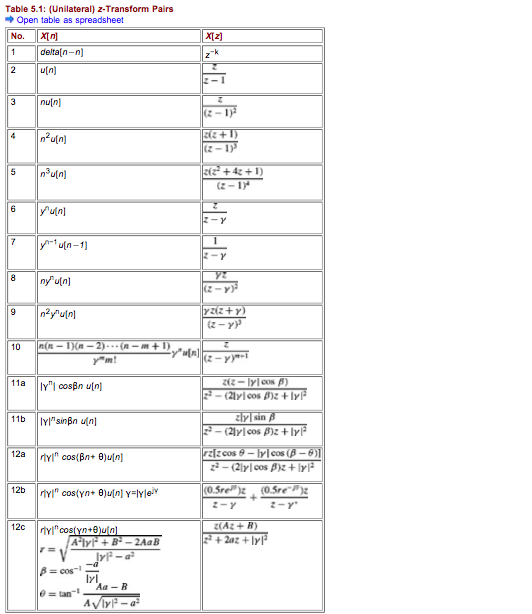z-Transform
Sometimes one has the problem to make two samples comparable, i.e. to compare measured values of a sample with respect to their (relative) position in the distribution. An often used aid is the z-transform which converts the values of a sample into z-scores:

2 Inverse Z-transform The goal of an inverse Z-transform is to get xn given X(z). Here are four ways to nd an inverse Z-transform, ordered by typical use: 1. Use a Z-transform table. (See additional handouts.) 2. Partial fraction expansion. Contour integration. Using the tables can be easiest, but they are not always. Table of (double-sided) Z Transform Pairs and Properties (Used in ECE301, ECE438, ECE538) (double-sided) Z Transform and its Inverse (Double-side) Z Transform. Find the Z-Transform of the function whose Laplace Transform is – ( 1) 1 ( ) + = s s F s The simplest method of obtaining the Z-Transform of the above function is to split the second-order transfer function into first-order transfer functions (whose Z-Transforms we know) via partial fraction expansion i.e. ( 1) 1 1 + = + + s b s a s s where a.
Z Transform Table Laplace
Table of Laplace and Z-transforms X(s) x(t) x(kT) or x(k) X(z) 1. – – Kronecker delta δ0(k) 1 k = 0 0 k ≠ 0 1 2. – – δ0(n-k) 1 n = k 0 n ≠ k z-k 3. S 1 1(t) 1(k) 1 1 1 −z−. The z-transform (ZT) is a generalization of the discrete-time Fourier transform (DTFT) for discrete-time signals, but the ZT applies to a broader class of signals than the DTFT. The two-sided or bilateral z-transform (ZT) of sequence xn is defined as The ZT operator transforms the sequence xn to X(z), a function of the continuous complex.
Modified Z Transform Table

Z Transform Table Examples

Z Transform Table Properties
with
zi ... z-transformed sample observations
xi ... original values of the sample
... sample mean
s ... standard deviation of the sample
The z-transform is also called standardization or auto-scaling. z-Scores become comparable by measuring the observations in multiples of the standard deviation of that sample. The mean of a z-transformed sample is always zero. If the original distribution is a normal one, the z-transformed data belong to a standard normal distribution (μ=0, s=1).
The following example demonstrates the effect of the standardization of the data. Assume we have two normal distributions, one with mean of 10.0 and a standard deviation of 30.0 (top left), the other with a mean of 200 and a standard deviation of 20.0 (top right). The standardization of both data sets results in comparable distributions since both z-transformed distributions have a mean of 0.0 and a standard deviation of 1.0 (bottom row).


| Hint: | In some published papers you can read that the z-scores are normally distributed. This is wrong - the z-transform does not change the form of the distribution, it only adjusts the mean and the standard deviation. Pictorially speaking, the distribution is simply shifted along the x axis and expanded or compressed to achieve a zero mean and standard deviation of 1.0. |